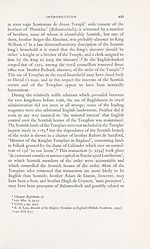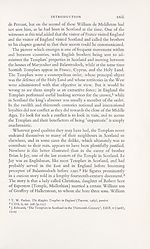Series 4 > Knights of St John of Jerusalem in Scotland
(27) Page xxii
Download files
Complete book:
Individual page:
Thumbnail gallery: Grid view | List view

xxii THE KNIGHTS OF ST JOHN
the family of Conyers, one of the leading families of the bishopric
of Durham at the end of the twelfth century.1
It has already been seen that the Scottish lands of the Templars
paid substantial responsions to the Temple in London up until 1296;
and this impression of dependence is reinforced in the records of
the trial of the Templars in Scotland.2 Of the four brothers of the
order in Scotland, two were arrested, Walter de Clifton and
William de Middleton, while the other two fled, John de Huseflete
and Thomas Totti (or Tocci); the last-named later gave himself up.
All four were English. Walter de Clifton said that he had joined the
Templars at All Saints’ tide in 1299 at Temple Brewer (Lincoln¬
shire), where he was received by William de la More, master of the
Templars in England and Scotland, who was his superior, whose
direct superior was the Master of Jerusalem and Cyprus and his
chapter. At his reception he had sworn to defend the Holy Land
and taken vows of poverty, chastity and obedience, also sworn
never to stay in a house where there were women or to attend
weddings or the churching of women. He had served for the last
three years at Balantrodoch, and before that had served for three
years at Temple Newsam (near Leeds, Yorkshire), one year at the
Temple in London, and three years at Temple Rockley (Wiltshire)
and Aslakeby (Lincolnshire). Before he took over at Balantrodoch
John de Huseflete had been preceptor there for two years. William
de Middleton told a similar story of his career as a Templar. He
had been received at Temple Newsom ‘seven years before’ by
brother Brian le Jay, who was then master of England (but who in
fact died in 1298, eleven years previously) in the presence of brothers
John de Huseflete, Thomas Tocci and John de Caratan, all of whom
had since fled, and other unnamed brothers who were now dead.
He had served in England for five years and in Scotland for two
years both at Maryculter and at Balantrodoch, and in Northumber¬
land ‘by agents’ for three years. He said that Scotland was subject
to the master of England, he in turn to the master of France, and
he in turn to the master of Cyprus. Twice since he had joined the
order there had been visitations from the visitor of France, Hugh
1 RRS, ii, 177-8, where the name is spelt ‘Coigneres’
* Spottiswoode Misc. ii, 1-16 (transcribed from Wilkins, Concilia, ii, by James
Maidment)
the family of Conyers, one of the leading families of the bishopric
of Durham at the end of the twelfth century.1
It has already been seen that the Scottish lands of the Templars
paid substantial responsions to the Temple in London up until 1296;
and this impression of dependence is reinforced in the records of
the trial of the Templars in Scotland.2 Of the four brothers of the
order in Scotland, two were arrested, Walter de Clifton and
William de Middleton, while the other two fled, John de Huseflete
and Thomas Totti (or Tocci); the last-named later gave himself up.
All four were English. Walter de Clifton said that he had joined the
Templars at All Saints’ tide in 1299 at Temple Brewer (Lincoln¬
shire), where he was received by William de la More, master of the
Templars in England and Scotland, who was his superior, whose
direct superior was the Master of Jerusalem and Cyprus and his
chapter. At his reception he had sworn to defend the Holy Land
and taken vows of poverty, chastity and obedience, also sworn
never to stay in a house where there were women or to attend
weddings or the churching of women. He had served for the last
three years at Balantrodoch, and before that had served for three
years at Temple Newsam (near Leeds, Yorkshire), one year at the
Temple in London, and three years at Temple Rockley (Wiltshire)
and Aslakeby (Lincolnshire). Before he took over at Balantrodoch
John de Huseflete had been preceptor there for two years. William
de Middleton told a similar story of his career as a Templar. He
had been received at Temple Newsom ‘seven years before’ by
brother Brian le Jay, who was then master of England (but who in
fact died in 1298, eleven years previously) in the presence of brothers
John de Huseflete, Thomas Tocci and John de Caratan, all of whom
had since fled, and other unnamed brothers who were now dead.
He had served in England for five years and in Scotland for two
years both at Maryculter and at Balantrodoch, and in Northumber¬
land ‘by agents’ for three years. He said that Scotland was subject
to the master of England, he in turn to the master of France, and
he in turn to the master of Cyprus. Twice since he had joined the
order there had been visitations from the visitor of France, Hugh
1 RRS, ii, 177-8, where the name is spelt ‘Coigneres’
* Spottiswoode Misc. ii, 1-16 (transcribed from Wilkins, Concilia, ii, by James
Maidment)
Set display mode to:
![]() Universal Viewer |
Universal Viewer | ![]() Mirador |
Large image | Transcription
Mirador |
Large image | Transcription
Images and transcriptions on this page, including medium image downloads, may be used under the Creative Commons Attribution 4.0 International Licence unless otherwise stated. ![]()
| Scottish History Society volumes > Series 4 > Knights of St John of Jerusalem in Scotland > (27) Page xxii |
|---|
| Permanent URL | https://digital.nls.uk/126637839 |
|---|
| Description | Over 180 volumes, published by the Scottish History Society, containing original sources on Scotland's history and people. With a wide range of subjects, the books collectively cover all periods from the 12th to 20th centuries, and reflect changing trends in Scottish history. Sources are accompanied by scholarly interpretation, references and bibliographies. Volumes are usually published annually, and more digitised volumes will be added as they become available. |
|---|


